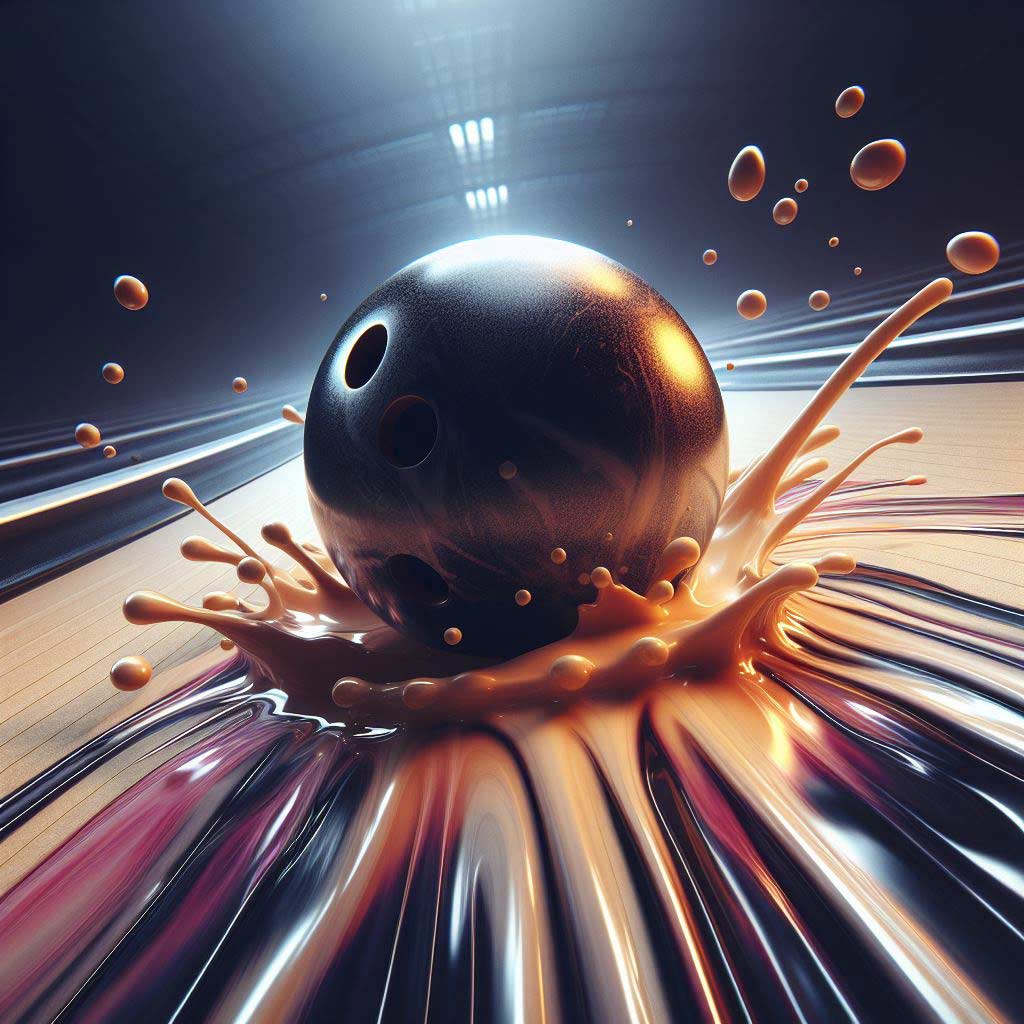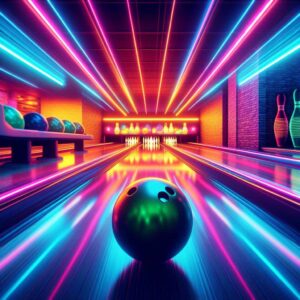Bowling lanes seem slick and slippery, allowing bowling balls to glide smoothly down to knock over the pins. But have you ever wondered exactly why wood or synthetic bowling lanes can be so slick?
There are actually several scientific reasons that come together to create the slippery bowling lane conditions that players experience.
In this complete guide, we’ll uncover all the factors that contribute to making bowling lanes slippery. From the lacquer finish to the lane oil, wear and tear, and humidity, we’ll explain the bowling science behind the slide.
With a better understanding of what makes lanes slippery, you can adjust your game and bowling ball to match the lane conditions. Let’s get rolling!
The Bowling Lane Surface
The basic structure of a bowling lane provides the foundation for slippery conditions. Modern bowling lanes are made from maple wood or a synthetic material overlaid on top of a wood core. While wood was traditionally used, many newer lanes utilize a durable synthetic material for the lane surface.
This lane surface material is coated with a glossy lacquer finish. The lacquer penetrates deep into the wood or synthetic material, sealing and protecting the lanes.
This liquid plastic coating then dries into a smooth, shiny surface that adds to the slickness. The lacquer’s glossiness and smoothness significantly reduce friction between the bowling ball and the lane. Without any texture or grip, balls can glide with very little resistance.
Lane Oil Patterns
On top of the lacquered lane surface is the major contributor to slippery conditions – lane oil, also called lane conditioner. Lane oil is applied in precise patterns by an automated lane conditioning machine. This thin oil film further reduces friction and allows bowling balls to slide easily into a controlled hook or curve down the lane.
Lane oil is typically made from a blend of mineral oil and other additives like silicone and glycerine. It varies in viscosity and application amount depending on the desired oil pattern.
Before bowling competitions, the oil is applied from the conditioning machine which moves back and forth across the lane squirting a measured amount of oil.
The oil is distributed in lighter and heavier concentrations in certain board zones from side to side to create a specific oil pattern. Common patterns include house shots, sport shots, and tournament shots which feature different oil layouts. The patterns influence ball motion and add to the slipperiness in defined zones across the lane.
More oil in the middle allows more skid, while less oil near the gutter brings balls into an earlier hook. Heavier volumes result in more slippery conditions. The oil takes time to soak into the lacquered wood surface and spread out from bowlers’ balls rolling over it through a tournament.
Wear and Tear Over Time
In addition to the lacquer and lane oil, the natural effects of wear and tear on a bowling lane over many years increase slickness. As thousands of bowling balls roll down the lane, the rolling friction polishes and smoothens the wood or synthetic surface. This wears down the texture, making it shinier and slicker.
The lane oil also absorbs deeper into the surface material as the lanes age from repeated oiling and bowling. This helps the oil spread out more and penetrate deeper to reduce friction between each ball and the lane. As the lacquer finish also gets thinner with age, the oil has less resistance.
Routine Cleaning and Maintenance
To maintain optimal bowling conditions, lanes require frequent cleaning and maintenance. Lane cleaning machines use various solvents, detergents, and abrasives to clean dirt, debris, and oil residue off the lane surface. However, this cleaning process combined with refinishing also enhances the slickness.
The detergents strip oil and dirt out of the wood or synthetic material, opening pores and smoothing the surface. Refinishing fills in divots and scratches to restore a glossy, like-new lacquer coating after hundreds of games. Fresh lacquer and deep cleaning result in hyper-slick lanes before the oil is even applied.
Humidity and Moisture Effects
The climate and environment around the bowling center can also impact lane slickness. Wood naturally expands and contracts with changes in heat or humidity. As humidity rises in the air, wood lane beds will absorb moisture and swell, expanding the gaps between the individual lane boards.
Higher humidity causes the wood to get stickier and shinier. But at the same time, wider gaps between boards create more variation and unpredictability for bowling balls rolling over changing seams and edges. This mix of stickiness yet unevenness from moisture creates additional slippery factors.
Synthetic lanes are not as affected by humidity and lie flatter than natural wood. But moisture in the air still contributes to some slippery film on the lane Surface. The slick feel of humid air transmits to balls gliding over the oiled lane.
Putting It All Together
All these factors work together to produce the slippery bowling lane conditions that players experience. The lacquer sealant provides a glossy, smooth foundation for the lanes. Lane oil in precise patterns adds high and low friction zones across the lanes.
The polished wear over thousands of games combined with routine deep cleaning removes grip and texture from the surface. And humidity introduces uneven, sticky spots for bowling balls to slide over.
Now that you understand the science behind what makes bowling lanes slippery, you can use this knowledge to adjust your game. With the right bowling ball for oily lanes, release technique, and line adjustments you can control the slide and conquer even the slickest bowling center!
Adjusting Your Game for Slippery Bowling Lanes
Facing slippery lane conditions? Don’t worry, you can make adjustments to your game to match the increased slide of the lanes. With the right strategy, balls, and technique you can aim the ideal line and strike even on wet and oily lanes.
Use the Correct Bowling Ball
Selecting the right bowling ball is the first step to managing slippery lanes. You want equipment that is designed to handle excess oil and provide traction through the slick spots. Using plastic or urethane balls on oily lanes will result in wild over hooks and potential gutter balls.
Look for a reactive resin ball that has a low differential, or difference between the oil absorption rates of the coverstock and core. This will provide a smoother, more controlled hook in heavy oil conditions.
Duller finishes without much surface roughness also fare better. Polish your reactive ball to increase length and reduce friction for oily lane play.
Adjust Your Starting Position and Footwork
Make alignment adjustments based on the oil pattern to avoid trouble areas. If the middle is heavy, start more to the side and use fewer cross-over steps to go straighter initially. For dry outsides, start from the middle and increase foot speed to get through that zone quicker.
Take care with your steps and push off to not slip. Lower ball speed helps, so don’t rush and stay balanced. Keep feet under your shoulders and take medium, controlled steps. Sliding too much or fast at release leads to inconsistency on slippery approaches.
Tweak Ball Speed and Rev Rates
Higher ball speeds extend the skid length through oil before the hook point. But too fast can get uncontrollable on slick lanes. Try increasing speed by just 1-2 mph for more momentum to avoid over-hooking. Lower and consistent speeds are also effective.
Higher rev rates increase hooking action, so smooth spinners and strokers may fare better than power players on wet lanes. Reduce hand and wrist strength at release to minimize revs and flare potential that grabs too early.
Aim Your Mark and Hit Your Target
Identify where the slipperiest zones are and avoid those at release. Use visual markers well down the lane at the breakpoint to hit your mark. Release the ball out toward the gutter if the center oils heavily.
Adjust your visual target and breakpoint to be further down the lanes, adding 5-10 feet from where you would normally play. Let the ball naturally slide into the pocket. Keeping the ball online avoids the dry outsides.
Make Proactive Adjustments
Stay ahead of transition by making ball and line changes early. Move inward or change the ball surface as carry declines before it becomes a major issue. Keep an eye on ball motion and where it loses energy.
Find reliable reference points and keep notes on what works. Maintain consistency in steps, speed, release, and breathing to control what you can. Slippery lanes require a proactive mindset and adjustments.
Practice Controlling the Slide
Bowl and practice on sport shots or wet lanes to gain experience handling slick conditions. Learn how different balls and surfaces respond. Play deeper angles and force yourself to stay in the oil.
Focus on repeatable foot speed, timing, and marks. Work on reducing muscle and maintaining balance for a smooth release. Become comfortable with seeing a controlled slide.
The bowlers who can embrace the slipperiness and make smart adjustments will gain an advantage. By understanding what makes bowling lanes oily and adapting ball motion, footwork, and targets, you can master even the slickest lane challenges. Don’t fear lane oil – learn to use it to your benefit.
The Best Bowling Balls for Slippery Lanes
Having the right bowling ball for oily lane conditions is critical for control and scoring. Certain ball features and coverstock properties allow the ball to handle excess oil and sliding mieux. Here are the top ball recommendations for slippery lanes:
Roto Grip Hustle Ink
The Hustle Ink by Roto Grip stands out on wet/dry lanes with its hybrid reactive coverstock and modified RG core. The S77 hybrid reactive material provides length through oil with a smooth response to friction. The core creates an easy rolling motion without overhooking.
This combination makes the Hustle Ink ideal for medium to light oil patterns when lanes start transitioning to drier slickness. The matte finish is mid-range aggression controlling the backend reaction. Multiple weights suit both speed and rev-dominant players.
Storm IQ Tour Emerald
Storm’s IQ Tour Emerald offers a trio of technologies to unlock control on oily lanes – the R2S hybrid cover, inverted feather core, and 360-degree RG specification. This improves tracking and reduces overreaction to oil.
The Emerald cuts cleanly through the fronts with minimal hooking action. But the Ultra Flip core provides backend continuation on the dry portion. A slightly lower differential brings aggressive players to the pocket consistently.
Roto Grip IDOL Synergy
Designed for heavy rolling friction, the Roto Grip IDOL Synergy handles wet/dry as well as anyone. The gear additive in the coverstock allows it to penetrate oil and dig in earlier. The core optimizes revs with a controlled motion.
The IDOL Synergy is ideal for strokers and speed-dominant players, maximizing their power source – speed. The knockdown reaction shines on medium sports shots. Multiple surface tunings optimize reaction length.
Columbia 300 Nitrous
Featuring Columbia 300’s patented Boost/R Boost coverstock technology, the versatile Nitrous provides length and a smooth response to friction down lane. This makes Nitrous ideal for when the heads soak up oil but the backends get slippery.
The boost additive mixed into the coverstock allows it to gain traction in oil for a robust backend reaction. The advanced core geometry adds revs and power. Together this makes Nitrous excel on tricky sport patterns and house shots.
With the right bowling ball, a bowler can tame even the most demanding oily lane conditions. Determine your ball speed, rev rate, and bowling style to select equipment suited for slippery lanes from this list of top performers.
Mastering Lane Play Adjustments for Wet Lanes
Slick and oily lane conditions require making proactive adjustments in target lines, speeds, and release. Here are key lane play tips to maximize scoring when the lanes get wet and slippery.
Move In Early
As the oil pattern wears down, make your first move inwards quickly, within the first few frames, rather than allowing too many bad shots. Shifting inside early offsets the loss of backend friction. Pay attention to where the roll begins hooking and adjust accordingly.
Keep Shoulders Square
Aiming properly is more difficult on slippery lanes since the breakpoint is harder to visualize. Concentrate on keeping shoulders and eyes lined up square to your target at release. This keeps the ball online and prevents uncontrolled sideways hooking from muscling.
Adjust Speed as Needed
Adjust ball speed depending on transition. Increase speed 1-2 mph if the hook comes too early. Slower speed may be optimal if the oil has soaked in fully. Time the approach to arrive at the line with optimal speed based on lane conditions.
Get Left of Dry Spots
Refresh oil will dry out quickest on the outer boards. If you hear the ball rattling through that section, get left of the dryness before release. Moving inside late prevents the ball from seeing friction too early off the dry.
Play Straight Whenever Possible
Using most or all of the lane before hooking minimizes over-reaction to slick/dry spots. Simplify the breakpoint to just past the end of the oil pattern. Let the oil and lane surface dictate ball motion rather than big hooks.
Trust Your Adjustments
Have conviction in your moves and equipment changes on transitioning lane conditions. Stick with adjustments over multiple frames to verify performance. Avoid second-guessing yourself in the moment over single shots. Slippery lanes reward decisiveness.
Making the right moves at the right time keeps balls in play and scores high on wet, oily lane patterns. Next time the lanes get slick, utilize these lane play tips and tricks.
How Lane Conditions Impact Ball Motion
To complement smart lane play, understanding how lane conditions influence ball motion is key. Different oil patterns and slick factors have the following effects:
Heavy Oil Volumes
- More oil allows for greater length and skid
- Balls transition later and smoother into the hook
- Can reduce backend power if too much oil remains
Light Oil Volumes
- Ball hooks earlier and more abruptly
- Have less room for error in ball trajectory
- Changes reaction plans to suit dry lanes
Uneven Oil Distribution
- Inconsistent oil patterns make ball react unpredictably
- Ball may slide too long in some spots and grip suddenly in others
- Requires quick adjustment and avoiding trouble spots
Worn/Polished Lanes
- Slide length increases and backends become less defined
- The smoother surface reduces midlane friction
- Ball doesn’t read the midlane as clearly
Lane Transition
- As oil moves and dries up, the break point must move left
- All parts of lane will demand adjustments as it transitions
- Bowlers have shorter adjustment window on fast transitions
Knowing oil patterns, slick spots, and transition rates allows selecting the optimal ball, speed, and target. Make sure to communicate changing lane conditions with teammates as well. Observe, analyze, and adjust to maximize scoring.
With this comprehensive guide on what makes bowling lanes slippery, you now understand all the factors at play – from lacquer finishes to lane oil patterns and transitions.
Use the tips provided to match the right equipment, adjust angles, footwork, and delivery for your bowling style. This knowledge will help you get a grip on slick lane conditions and maintain high scores.
Frequently Asked Questions
How do they make bowling alley so slippery?
Bowling lanes are made slippery using lacquer finishes, lane conditioning oils, and routine cleaning and refinishing of the wood or synthetic lanes. This reduces friction so bowling balls can slide smoothly before hooking into the pins.
Why do they put oil on bowling lanes?
Lane oil, also called lane conditioner, is applied in precise patterns to allow controlled sliding of the bowling balls. The oil reduces friction and allows the ball to skid through the oily part of the lane before encountering friction and hooking. Different oil patterns influence ball motion.
What is the slippery part of a bowling alley called?
The actual lane surface that is slippery is called the lane bed. This can be made of wood or a synthetic material. The slippery coating on top is called a lacquer finish. The other slippery substance applied to lanes is lane oil or conditioner.
What kind of oil is used on bowling alleys?
The oil used on bowling lanes is called lane conditioner. It is typically a blend of mineral oil mixed with other additives like silicone oil or glycerine to vary viscosity and application.
Why can’t you wear street shoes in bowling alley?
Bowling alleys don’t allow street shoes because the dirt and rocks from outside can damage delicate wood or synthetic lanes. The rental bowling shoes have soft rubber soles that don’t scratch the lane surface.
Do they grease bowling lanes?
No, bowling lanes are not greased. They are coated with a lacquer finish and conditioned with lane oil. Grease would be too thick and heavy for bowling. Lane oil provides just the right slipperiness for controlled ball slides.
What is Rule 31 in bowling?
Rule 31 governs proper maintenance of the bowling lane surface. It defines protocols for lane cleaning, conditioning oil procedures, and refinishing to ensure fair playing conditions.
Are bowling alleys oiled or waxed?
Bowling lanes are oiled or conditioned, not waxed. The lane oil provides an optimal amount of slickness. Wax would make the lanes too slippery and unplayable.
How do you tell if a bowling lane is dry or oily?
On dry lanes, the ball will hook earlier and sharper. On oily lanes, the ball will slide longer before a smooth backend hook. Observing ball reactions compared to your normal targeting helps determine if lanes are dry or oily.





